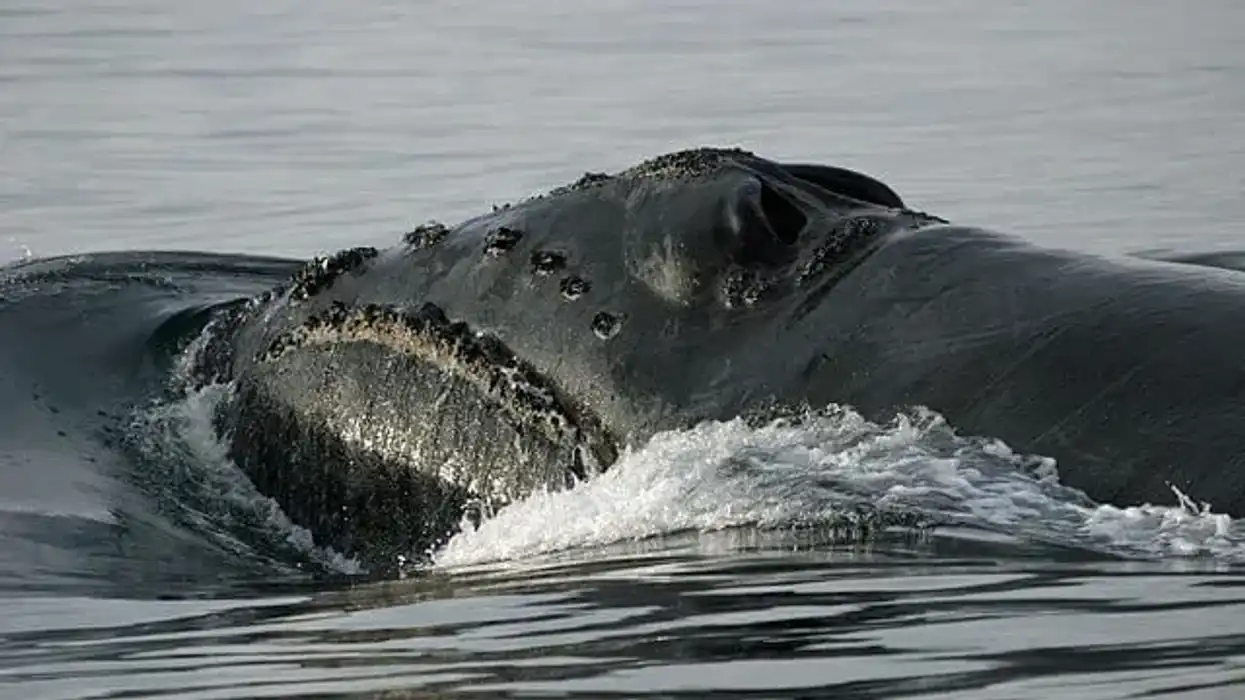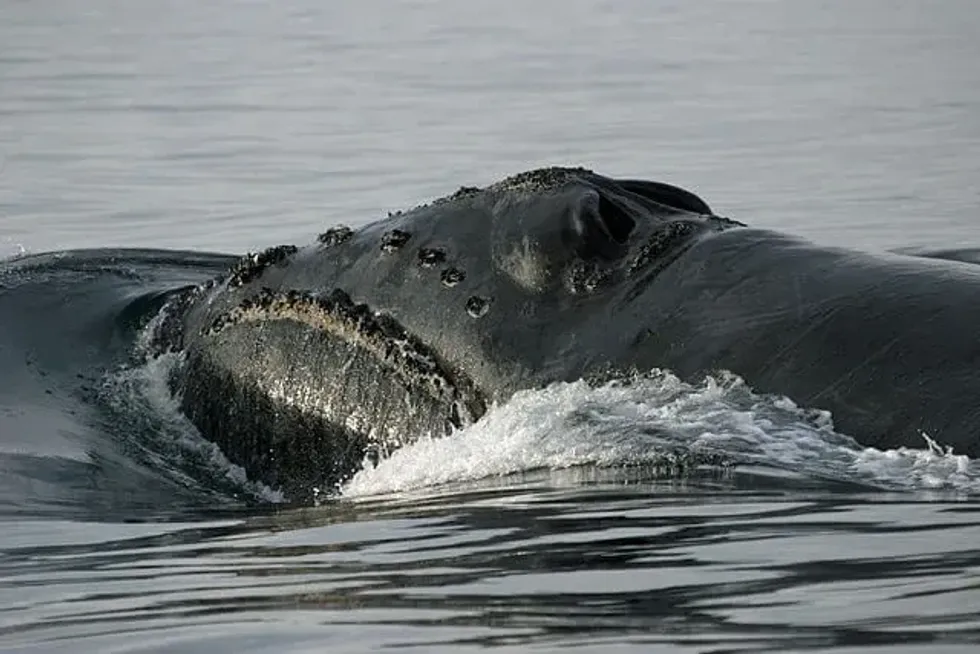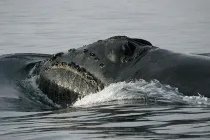Fun North Pacific Right Whale Facts For Kids
The North Pacific right whale is a species of right whale endemic to the North Pacific Ocean, near the countries of the USA (Gulf of Alaska), Japan, and Russia.
The waters alongside Japan, and the Bering Sea, and the Okhotsk Sea inhabit the dwindling populations of the North Pacific right whale species. This large whale is found between latitudes of 20-60 degrees and favors shelf or coastal waters as well as deep waters.
North Pacific right whales migrate to lower latitude habitats in the winter but favor higher latitudes in the summer.
They are mild-mannered mammals that even show affection to each other and do not fight for territory or mating rights. Their populations are critically endangered in the eastern north Pacific and endangered in the western North Pacific.
Global warming, entanglement, vessel strikes, oil spills, ocean pollution are furthering endangering the North Pacific right whale species, but whaling in the 19th and 20th centuries played a major role in the declining population.
For more relatable content, check out these minke whale facts and sei whale facts for kids.
North Pacific Right Whale Interesting Facts
What type of animal is a North Pacific right whale?
The North Pacific right whale (Eubalaena japonica) is a whale, a marine mammal, and a cetacean.
What class of animal does a North Pacific right whale belong to?
The North Pacific right whale (Eubalaena japonica) belongs to the Mammalia class of animals.
How many North Pacific right whales are there in the world?
There are about 300-400 North Pacific right whales left in the world. Of these, 30-35 are present in the eastern North Pacific critical habitat range and 300 or so are present in the western North Pacific range.
Where does a North Pacific right whale live?
The North Pacific right whales range from Russia to Japan in their western habitat and Alaska and the North American west coast in their eastern North Pacific critical habitat. They live between 20-60 degrees latitude but favor higher latitudes in the summer.
These whales migrate to coastal areas and lower latitudes in the winter. The Sea of Okhotsk, Aleutian Islands, Bering Sea, and the Gulf of Alaska constitute the summer range of North Pacific right whales.
The North Pacific right whale location in winter could be in the Sea of Japan, Ogasawara Bunto, Taiwan straits in the western Pacific ocean. The Baja California coasts also have North Pacific right whales in the winter.
The North Pacific right whale population may have dwindled significantly in these typical habitats because now they are mostly seen in the shelf and coastal or deep waters alongside Japan, or in the southeastern parts of Bering, or the Sea of Okhotsk. Sightings of right whales are rare.
What is the North Pacific right whale's habitat?
North Pacific right whales primarily occupy shelf or coastal waters. These baleen whales have also been observed in deep waters.
They favor higher latitude habitats in the summer, which relate to the availability of prey. The habitat of North Pacific right whales can be classified into four types: calving, feeding, breeding, and nursery.
Feeding grounds see seasonal migrations in search of prey like krill and copepod. Calving habitats come in use for neonatal nursing purposes. The young North Pacific right whales are taken to the feeding grounds in the lower-latitude, coastal, and shallow waters suckling in the winter.
The breeding areas in the Bering Sea, Okhotsk Sea, Aleutian Islands, and the Gulf of Alaska are populated in the summer months. Southeastern Bering Sea sees North Pacific right whales during July-October and only for a handful of days at a given time.
Who does the North Pacific right whale live with?
North Pacific right whales haven't been observed sufficiently because of their rarity. They have been seen alone and in small groups. Other related species also live in small mixed groups of up to 12 whales, the same can be assumed for North Pacific right whales.
How long does a North Pacific right whale live?
Little is known about the lifespan of North Pacific right whales, but it has been inferred that they live to be at least 70 years old.
How do they reproduce?
North Pacific right whales reproduce by mating and laying eggs.
The mating systems of North Pacific right whales are similar to North Atlantic right whales and southern right whales. Non-aggressive aggregations for mating are formed where individual whales engage in nuzzling and mild physical contact.
There is no competition for females among males and females may take on multiple partners. Mating behaviors include tail and fin slapping near the surface, breaching, and headstanding. Headstanding is when right whales float near the surface in a configuration that is vertical while extending their flukes in the air.
They may also sway back and forth for several minutes while headstanding. Tail and fin slapping and breaching are more common mating displays than headstanding.
North Pacific right whales have sexual organs on their abdomen. There is no baculum or scrotum, but there are exceptionally large testes.
Testis as big as 30.7 in (78 cm) in diameter and 79 in (201 cm) in length and 1,157 lb (525 kg) in mass were observed on one right whale. And the biggest ovaries weighed over 14 lb (6.4 kg).
The reproductive rates are very low, birth is given to a single offspring every 3-4 years. The gestation period lasts over a year. The breeding season is in winter and birthing comes next spring. The lactation period may last for 6-7 months.
Weaning is prolonged and gradual. Newborn whales are 13-20 ft (4-6 m) long. Males and females attain maturity when they're 10 years of age, males when they're 50 ft (15.2 m) long and females when they're 52 ft (15.8 m) long.
What is their conservation status?
The conservation status of the North Pacific right whale species according to the International Union for Conservation of Nature is Least Concern.
North Pacific Right Whale Fun Facts
What does North Pacific right whale look like?
North Pacific right whale size is huge and their heads make up one-third of their length. The body length of female whales is longer than that of male whales.
The skin of these baleen whales is mostly black, with white patches on the underside. These baleen whales have something called callosities, which are patches of thickened skin.
Callosities are present near the eyes and blowholes and on the lower lip and chin. These callosities from after birth may harbor whale lice and barnacles, making them look pink, white, or yellow.
The largest callosity is on the rostrum and is called the bonnet. Callosities and white underside patches are what distinguishes North Pacific right whales from bowhead whales, although callosities sometimes break off.
North Pacific right whales have rounded, broad flippers and they lack a grooved throat, a dorsal fin, and a ridge. The broad tail is all black and notched in the middle with a trailing edge.
The broad flippers are fan-shaped. These marine mammals also have massive jaws.
The baleen plates in their mouth have a brownish-gray appearance and there are 200-270 on each side. They can be as long as 10 ft (3 m). The blowholes on the dorsal side are separated and exhalations cause the V-shaped blows to go as high as 16.4 ft (5 m).
North Pacific right whales have a single fused unit of seven cervical vertebrae. The fat on whales known as blubber can be as thick as 28 in (71 cm).
The blubber is basically 45% of the whale's mass. The flippers of North Pacific right whales are wider and larger than South Pacific right whales.

How cute are they?
North Pacific right whales are truly magnificent creatures. They are beautiful, black, shiny, and massive marine animals.
They are really gentle and non-aggressive in nature, and they even show affection by nuzzling each other. They don't compete for mates and are always tender towards females and young ones. They are also capable of uttering simple and complex vocalizations and it's a shame that these majestic beings are under an immediate threat of extinction.
How do they communicate?
North Pacific right whales communicate via vocalizations that are simple and complex and have a low frequency. The belch-like sounds include grunts, moans, bellows, and sighs. The calls last for 0.7 seconds and have a frequency of 90-150 Hz. The calls occur more than 10 seconds apart at irregular intervals.
How big is North Pacific right whale?
North Pacific right whales are 49-60 ft (15-18.3 m), which makes them 10-12 times bigger than the porbeagle sharks and 8-10 times bigger than southern right whale dolphins.
How fast can a North Pacific right whale swim?
The North Pacific right whale is a characteristically slow swimmer. On average, this marine mammal moves at 3 mph (4.8 kph) and only go as high as 5.6 mph (9 kph)
How much does a North Pacific right whale weigh?
A North Pacific right whale weighs anywhere between 110,231–220,462 lb (50,000-100,000 kg).
What are the male and female names of the species?
Since they are mammals, males of the North Pacific right whale species are called bulls and the females are called cows.
What would you call a baby North Pacific right whale?
A baby North Pacific right whale is called a calf.
What do they eat?
The North Pacific right whale diet consists of zooplanktonic crustaceans, calanoid copepods, krill, and larval barnacles. This marine mammal is a filter feeder.
Adult whales face no predatory threat because of their size but the calves may fall victim to killer whales and bigger sharks. The main threat comes from humans.
Are they poisonous?
No, North Pacific right whales are not poisonous.
Although in Japan, whale meat may have high levels of mercury and toxins.
Would they make a good pet?
No, they would most definitely not make a good pet because they're huge and endangered.
Did you know...
The species of right whales get their name from the belief that they are the 'right' whales to capture.
North Pacific right whale species was considered conspecific with the North Atlantic right whale species. It got separated from the North Atlantic right whale, thanks to genetic evidence.
The North Atlantic right whale is Critically Endangered and the southern right whale is a species of Least Concern. North Atlantic right whales are important because they're a marvel of nature and they form an essential part of the ocean food chain.
Sightings of right whales over their large geographic range are really rare.
What do North Pacific right whales look like?
North Pacific right whales are humongous, black, shiny, and calloused in patches. They have some white patches on their undersides and are often seen releasing blowholes as high as 50 ft (15 m). They have no large baleen plates and jaws and have no dorsal fins.
Why is the North Pacific right whale endangered?
There are many reasons why the North Pacific right whales are endangered. Today, they are really rare and it is difficult for whales to find mates over their large habitat range and this may cause inbreeding.
Global warming and climate change, ocean pollution, oil spills, and ship collisions pose a major threat to this large whale species as well. Whaling in the 19th century cut down their numbers significantly.
As many as 37,000 whales were killed from 1839-1909. After they became protected in 1946, they were still illegally hunted, mostly by Soviet ships in their eastern North Pacific critical habitat.
The eastern population is Critically Endangered and the western population is considered Endangered by the IUCN. Entanglements also contribute to the declining populations of North Pacific right whales.
The North Pacific right whale, the western and eastern population, is an Endangered species as per the Endangered Species Act by the NOAA.
Here at Kidadl, we have carefully created lots of interesting family-friendly animal facts for everyone to discover! For more relatable content, check out these sperm whale interesting facts and spinner dolphin fun facts for kids pages.
You can even occupy yourself at home by coloring in one of our free printable whale letter coloring pages.
We Want Your Photos!
More for You
See All
Bachelor of Arts and Law specializing in Political Science and Intellectual Property Rights

Anusuya MukherjeeBachelor of Arts and Law specializing in Political Science and Intellectual Property Rights
With a wealth of international experience spanning Europe, Africa, North America, and the Middle East, Anusuya brings a unique perspective to her work as a Content Assistant and Content Updating Coordinator. She holds a law degree from India and has practiced law in India and Kuwait. Anusuya is a fan of rap music and enjoys a good cup of coffee in her free time. Currently, she is working on her novel, "Mr. Ivory Merchant".
Disclaimer
1) Kidadl is independent and to make our service free to you the reader we are supported by advertising. We hope you love our recommendations for products and services! What we suggest is selected independently by the Kidadl team. If you purchase using the Buy Now button we may earn a small commission. This does not influence our choices. Prices are correct and items are available at the time the article was published but we cannot guarantee that on the time of reading. Please note that Kidadl is a participant in the Amazon Services LLC Associates Program, an affiliate advertising program designed to provide a means for sites to earn advertising fees by advertising and linking to Amazon. We also link to other websites, but are not responsible for their content.
2) At Kidadl, we strive to recommend the very best activities and events. We will always aim to give you accurate information at the date of publication - however, information does change, so it’s important you do your own research, double-check and make the decision that is right for your family. We recognise that not all activities and ideas are appropriate for all children and families or in all circumstances. Our recommended activities are based on age but these are a guide. We recommend that these ideas are used as inspiration, that ideas are undertaken with appropriate adult supervision, and that each adult uses their own discretion and knowledge of their children to consider the safety and suitability. Kidadl cannot accept liability for the execution of these ideas, and parental supervision is advised at all times, as safety is paramount. Anyone using the information provided by Kidadl does so at their own risk and we can not accept liability if things go wrong.
3) Because we are an educational resource, we have quotes and facts about a range of historical and modern figures. We do not endorse the actions of or rhetoric of all the people included in these collections, but we think they are important for growing minds to learn about under the guidance of parents or guardians.







